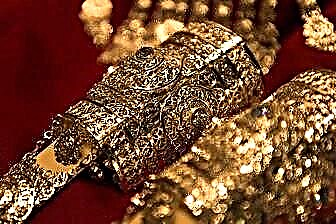Address: Germany, Cologne
Start of construction: 1248 year
Completion of construction: 1880 year
Architect: Gerhard von Riele
Height: 157 m
Shrines: Casket of the Three Wise Men, miraculous sculpture of the Milan Madonna, Cross of Hero
Coordinates: 50 ° 56'28.7 "N 6 ° 57'29.2" E
Content:
Brief description
The famous Cologne Cathedral, built in the Gothic style, is undoubtedly the most recognizable and most famous temple in the whole world. All tourists who come to Germany consider it their duty to look at this majestic building, which is the third highest among all the temples on our planet.

Cathedral from a bird's eye view
Cologne Cathedral can be called a monument to all mankind, because its construction, which began in 1248, continues in our time, and, probably, it will not be completed soon, if it will be completed at all. There is an ancient legend associated with the Cologne Cathedral, which says that when the cathedral is finally erected, the end of the world will come. It is everyone's business to believe in this legend, or to consider it an implausible myth, but the construction and reconstruction of the Cologne Cathedral continues in the 21st century, a century of technological progress, in which there is no place for speculation, riddles, hoaxes and legends.
The height of the Cologne Cathedral is able to enter a tourist who visited Cologne for the first time into a state of silent shock. 157 meters - this is the height of the architectural structure, which at first glance seems to be airy and "weightless", despite its huge area. Near the Cologne Cathedral, almost at any time of the day, you can meet crowds of tourists with cameras who wish to capture in pictures the building described by UNESCO as "one of the majestic creations of human genius." Cologne Cathedral is also a place of pilgrimage for Catholics from all over the world, because it contains not only priceless relics of the faith, but also rests the remains of numerous archbishops, numbered among the saints.

View of the cathedral from the opposite bank of the Rhine river
A large number of legends and secrets that envelop in a dense veil not only the Cologne Cathedral, but also the adjacent square, attract tens of thousands of paranormal researchers and esotericists to the city. The architectural structure, made in the Gothic style, quite often appears on wide screens in films shot in the genre of mysticism and horror. Naturally, there is nothing wrong with the elements of the Cologne Cathedral; most likely, it attracts directors and screenwriters with a gothic atmosphere and a legend about the devil himself. This legend deserves a more detailed consideration, therefore, about it, a little below ...
Cologne Cathedral - a holy place
If you approach the Cologne Cathedral, you can see that constant archaeological research is being carried out on the adjacent territory. Experts have long proved that the place where the Cologne Cathedral was built was considered a saint even 600 years before the arrival of the Savior in our world. As a result of the excavations, the ruins of ancient temples were found, which were built in honor of the pagan gods. However, even after the arrival of Christians in Cologne, various churches were constantly built on the site of the Cologne Cathedral, many of which were subsequently destroyed or burned.

View of the cathedral from Ronkalliplatz square
There is evidence that in the year 500, on the territory that is currently adjacent to the cathedral, a tomb was erected, in which archaeologists during excavations managed to find two bodies: a woman and a boy. Surprisingly, even after a huge period of time and constant construction work, the grave was not looted. It contains priceless exhibits made of gold, silver and precious stones. Naturally, this suggests that the people buried near the Cologne Cathedral belonged to one of the ruling dynasties. According to some historians, the Merovingian dynasty. As mentioned above, churches on this site were erected with enviable regularity. Apparently, the place where the Cologne Cathedral currently stands has always been considered sacred.
Cologne Cathedral - construction and a long history
If you look closely at history, the construction of the Cologne Cathedral can be divided into two stages. The first stage began in 1248... The idea of building a magnificent cathedral, which in its size and architectural forms was supposed to surpass the legendary French cathedrals, came to Archbishop Konrad von Hochstaden.

Facade Cathedral
True, the history of the Cologne Cathedral begins even earlier. It would be more correct to say that the Gothic architectural miracle dates back to 1164. At that time, no one thought about erecting a gigantic building yet. In 1164, the remains of three Holy Magi were brought to Cologne. They were a kind of trophy obtained as a result of the conquest of the Italian city of Milan. It was then that the Archbishop of Cologne began to think that the holy relics should be in a place worthy for them. Initially, in ten years, a sarcophagus was made for them, which is still available for viewing in the Cologne Cathedral. Ancient craftsmen made a shrine for the most precious shrine of Christianity from pure gold and noble silver, and a huge number of precious stones only emphasize the importance of the relics of the three Magi for believers. By the way, in many tourist avenues the relics of the Three Wise Men can be called the relics of the Three Kings.
In 1248, the foundation stone of the Cologne Cathedral was laid. By the way, the architect Gerhard did not develop its form on his own, but borrowed it from one of the temples in France. According to the project, the interior of the building should have been illuminated with natural light, which is why now, thanks to slender pilasters, the feeling of airiness of the building is being created.

South portal of the cathedral
It was decided to make the arches of the Cologne Cathedral pointed, which distinguished them from the arches of almost all French temples. In addition, pointed arches symbolize a person's aspiration upward - to God. The first to be built was the eastern part of the Cologne Cathedral. The construction lasted, according to documents that have survived to this day, a little over 70 years... During this time, an altar was erected, an internal choir, surrounded by a gallery. Once the choir was completed, construction began on the northern part of Cologne Cathedral. For this, it was necessary to demolish the Old Church, in which the divine services continued during the construction.
From the 14th to the 15th century, the naves on the southern part of the cathedral were completed and the three floors of the South Tower were built in succession. By the way, bells were installed on this tower in 1449, each of which had its own name "Speziosa" and "Pretitosa". In addition, at the beginning of the 15th century, the northern part of the cathedral was covered with a roof. Oddly enough, at this the first stage of construction was completed, and the cathedral, at the same time, stood unfinished until the 18th century.

Western facade of the cathedral
Cologne Cathedral - the legend of an architect
From the above, we can conclude that knowledge, endurance, patience were required from the architect who developed the plan for the Cologne Cathedral. By and large, he had to be a genius. There is a legend that says that the architect was never able to develop a plan for the magnificent cathedral. He was constantly confused in calculations and did not know what to do next with the drawings. He called himself to assistants…. the devil. He turned to Satan with a request to help him draw up a plan for the Cologne Cathedral. The devil replied that he would not help him, but would already bring ready-made drawings of the building, which in the future would become the most magnificent in the world.For this he asked only one thing - Gerhard's soul. The exchange of a drawing for a soul was to take place at the moment when the first cock crowed.
Gerhard's wife found out about this black deal, she could not allow her husband to exchange his soul for the drawings of the cathedral. The architect's wife, even after dark, crowed instead of a rooster, Satan immediately appeared and handed over the drawings. When a real rooster crowed, Gerhard already had the drawings and he could not give his soul to the devil. This is the kind of legend that goes around the main and first architect of the Cologne Cathedral. By the way, it still has a sequel. Deceived, Satan put a curse on the cathedral. He said that once the cathedral was completed, the world would end.

View of the cathedral towers
Cologne Cathedral - ongoing construction
Until the 18th century, the magnificent Cologne Cathedral, which many architects of the time called the wonder of the world, stood unfinished... Moreover, the erected choir was already in need of renovation. The second grandiose construction of the cathedral started in 1842. It was personally started by Frederick William IV. The original design, developed by Gerhard, was deemed correct and worthy for the cathedral in Cologne. As a result, it was decided to continue the work according to the first drawings. Already in 1880, the construction of the towers, the height of which reached 157 meters, was “completed”. However, the Cologne Cathedral continued to be constantly completed and restored: glass changed, decorations were added, gates were installed, and the interior was updated. In addition, in 1906, one of the decorative towers had to be restored, which suddenly collapsed.
World War II - an inviolable cathedral
Many are surprised by the fact that the legendary Cologne Cathedral was practically not damaged during the Second World War. Modern military strategists are trying to explain this: they argue that Soviet, British, American and French pilots did not drop bombs on the cathedral in order to use its tall towers as landmarks. Everything around was in ruins, among them, as if emerging from another world, stood the Cologne Cathedral.

Central portal of the western facade of the cathedral
If the strategy of the pilots is explained simply, then how can one explain the fact that numerous shells fired from long-range guns fell anywhere but on a Gothic cathedral? Apparently, he was still guarded by higher powers. Naturally, on the walls of the Cologne Cathedral in 1945 one could find a few traces of shrapnel and bullets, but they were rather "an exception to the rule." This "damage" was the reason for new restoration work. Interestingly, the company responsible for the restoration of the Gothic temple still works at its walls. Tourists today can see a small office building of this company not far from the cathedral.
Cologne Cathedral in the 21st century
Cologne Cathedral is now not only an architectural landmark, but also a place where some of the main shrines of Christianity are kept.... The aforementioned cancer with the relics of the three Magi, numerous burials of archbishops, the restored Milan Madonna are just a small part of the priceless treasures of the Cologne Cathedral. The most important shrines, which cannot be estimated in monetary terms, are exhibited in the treasury built on the foundation of the building.

View of the cathedral from the east
It is called the "Chamber of Shrines". All valuable Christian relics - the staff of St. Peter, the chest of the three Magi, the monstrance of St. Peter, wands and swords, made of precious metals and inlaid with precious stones, are under bulletproof glass and are highlighted by special searchlights. In addition, the treasury of the Cologne Cathedral is famous for its huge collection of ancient manuscripts, which tells about the many exploits of the saints. In the Cologne Cathedral, you can also see exhibits dating back to 500 AD. It displays objects made of gold, silver, rubies, diamonds and marble found in the "grave of a woman and a boy."
Of particular interest to the guests of the Cologne Cathedral Cross Geromade of oak. This was one of the first crucifixes in the entire Old World. Archbishop Gero, who returned from Byzantium in 976, decided to make a two-meter cross from a strong "eternal" tree. A huge number of believers come to this cross every day to offer their prayers to the Savior. The popularity of this sacred exhibit is not at all in the size of the crucifix, but in the way Jesus Christ is depicted on the cross.

Fragment of the roof
According to modern experts, it was almost impossible to reproduce the human body in such distant times in those distant times. Jesus Christ is depicted on the crucifix at the moment when his body dies, all muscles, protruding bones and even tendons are reproduced with extreme accuracy. Few people knew about the anatomical structure of humans in the first millennium. This is another of the many mysteries that the Cologne Cathedral holds.
Alas, hundreds of materials are not enough to describe all the charm of an architectural structure, to list all its treasures and shrines. Most tourists who have visited the Cologne Cathedral say that they do not want to leave the temple, and in order to at least partially get acquainted with its interior decoration, it will take at least a week. It takes even more time to feel the atmosphere that pervades everything even outside the building. It is no secret that any person, once inside the Cologne Cathedral, feels a sense of awe that makes him freeze in front of all the splendor for which the third largest temple on our planet is famous.

Fragment of a stained-glass window of the cathedral
The Cologne Cathedral is still under construction, many rooms are undergoing restoration, so it's too early to talk about the end of the world today. By the way, some sources say that when the cathedral is completed, not the end of the world will come, but Cologne will sink into oblivion. Probably, the Roman Catholic Church and numerous construction companies are in no hurry to check the veracity of the legend associated with the Cologne Cathedral and its first architect Gerhard.











